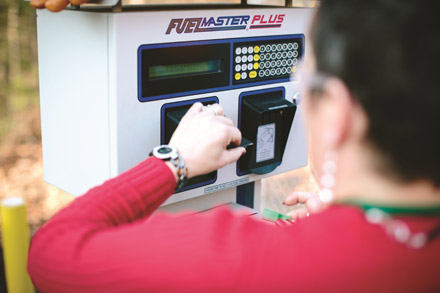Propane Autogas School Buses: A More Economical Solution for School Districts
Building a safe, green school bus is easy. All it takes is NASCAR’s top winning owner, a bus manufacturer willing to break from convention, a multi-million dollar investment by thousands of small businesses, school districts looking to do more with tight budgets and, of course, an affordable alternative fuel that reduces tailpipe emissions. As the world’s third most popular vehicle fuel, propane autogas is continuing to prove – from both a financial and environmental perspective – why it is worth the investment.
Propane is sometimes known as “liquefied petroleum gas,” “LP-gas” or “LPG.” Produced from natural gas and crude-oil refining, nearly 97 percent of propane used in the United States is produced in North America. It is safe, non-toxic and does not contaminate aquifers or soil. Propane is also colorless and odorless, which is why an identifying odor is added so the gas can be readily detected. Propane is the same gas that more than 40 million Americans use in small cylinders for their outdoor grills, more than 12.6 million Americans use to heat their homes and many more use in their standby generators when electric power goes out.
Propane, or “autogas” as it is known in Europe and Asia, is one of the world’s most widely used alternatives to gasoline and diesel. When compared to gasoline engines, propane eliminates fuel spills and reduces greenhouse gas emissions (GHG). According to a 2010 Propane Education & Research Council (PERC) Factsheet, “Propane Reduces Greenhouse Gas Emissions,” when compared to gasoline-fueled on-road engines and vehicles, such as the General Motors 6.0L engine, propane lowers GHG emissions by up to 25 percent. In gasoline-fueled commercial mowers, propane lowers GHG emissions by 48 percent. And, when compared to electric-powered residential space heating, propane lowers GHG emissions by 64 percent. It is a portable form of natural gas, and its unique characteristic of being stored as liquid under moderate pressure is why it finds its way into vehicles, backyard grills and so many other uses.
As a motor fuel, propane’s liquefied storage ability, compared with other gaseous fuels, allows more energy to be stored onboard a vehicle. It also enables propane to offer a similar driving experience and travel range to gasoline or diesel vehicles. With up to 56,000 miles of pipeline and nearly 6,000 retail dealer locations nationwide, propane is both widely available and easily portable.
A naturally low-carbon energy resource, propane autogas has been recognized as a clean alternative fuel by the Clean Air Act of 1990, and it powers millions of low-emission vehicles worldwide. As mentioned, when used in internal combustion engines, propane produces significantly fewer carbon dioxide emissions and up to 40 percent less carbon monoxide and nitrous oxide emissions.
Advancing Clean Technology for School Buses
Propane autogas’ efficiency and performance is also why Jack Roush, the legendary NASCAR owner and builder of high performance Mustangs, chose the fuel for his primary foray into alternative fuels. Today, the company he founded, Roush CleanTech, partners with Ford to build an array of propane-fueled vehicle models that are quickly gaining market share. These include light- and medium-duty trucks and vans as well as the Ford chassis used for full-size and smaller Blue Bird school buses. As might be expected from a company with a racing pedigree, the Roush-built engines make no compromise on performance and offer the same horsepower and torque as traditional bus engines.
Roush CleanTech teamed up with Blue Bird Corporation, one of the United States’ largest manufacturers of school buses, in 2010 to build propane-fueled engines for the company’s most popular selling alternative fuel buses, the Vision and Micro Bird. Blue Bird, a Georgia-based company known for its innovative design and manufacturing capabilities, leveraged Roush’s alternative fuel expertise with its extensive North American dealer and service network to capture a growing share of the highly competitive school bus market. To date, Blue Bird has sold more than 3,500 alternative-fueled buses nationwide.
Following the successful partnership model pioneered by Blue Bird and Roush CleanTech, more leading school bus manufacturers are now offering propane-fueled small buses than ever before. Collins, the nation’s largest “type A,” or small capacity bus manufacturer, services school districts nationwide with its propane autogas bus, including Portland Public Schools and Seattle Public Schools. Also, this year Thomas Built, the nation’s second largest school bus manufacturer, will introduce its own full-sized buses powered by a General Motors (GM) propane autogas engine.
Much of the initial investment to develop the Ford and GM propane autogas engines came from the Propane Education and Research Council (PERC), a check-off program established, operated and funded by the propane industry. PERC invests millions of dollars each year to advance workforce safety and training, consumer education, and research and development on a wide array of propane-fueled technology, including school buses. PERC research and development support has played a vital role in expanding the portfolio of propane-autogas-fueled vehicles on the market today.
Smart Investing for School Districts
Success in the school bus market requires school districts to be willing to move beyond conventional fuels at a time when budgets are squeezed in every direction. From coast to coast, districts are finding propane autogas offers a “green/green” solution, combining significant emission reductions and cost savings.
Propane autogas is a cleaner-burning, lower-carbon fuel than other conventional fuels, such as gasoline or diesel. School districts interested in curbing their carbon footprint are turning to school buses fueled by propane autogas because they produce fewer lifecycle greenhouse gas emissions per bus than those fueled with compressed natural gas or diesel. Additionally, research from the United Kingdom (UK) on emissions performance has shown that fueling with propane results in an estimated 80 percent reduction in smog-forming hydrocarbon emissions, which are linked to health problems like eye irritation, respiratory problems and lung damage.
Emission reductions are certainly important, but the effect of older diesel buses’ emissions on children’s health is creating a growing sense of urgency among parents, educators and school districts. Following last year’s decision by the World Health Organization (WHO) to classify diesel fumes as carcinogens, school districts are turning to alternative fuels like propane autogas to control the amount of pollutants children are exposed to while waiting at the bus stop or riding the bus.

Image Courtesy of Propane Education & Research Council
Additionally, in larger cities where noise pollution is a growing problem, buses running on propane autogas are much quieter compared to traditional-fueled models. In many ways, propane autogas is tailor-made for school districts’ bus fleets. In most parts of the country, school buses are centrally fueled fleets; that is, they are returned each day to a specific location or facility for cleaning, maintenance and refueling. The arrangement enables fleet managers to better control costs and to buy fuel in bulk quantities, which they can store and dispense at their own facilities. Propane refueling infrastructure, including storage tanks and dispensers, is a bargain. In most cases it costs less than installing gasoline or diesel refueling equipment. Also, propane purchased in bulk has saved many school districts $1.50 or more per gallon compared with gasoline or diesel.
Additional cost savings are available from new legislation authorized in recent “fiscal cliff” negotiations, which extends alternative-fuel tax credits for both infrastructure and fuel costs. The Alternative Fuel Excise Tax Credit was extended through this year and is retroactive for 2012. This means operators can receive 50 cents per gallon in tax credits for using propane autogas. Because school districts are exempt from income taxes, they receive direct payments from the federal government in lieu of tax credits.
Also, school districts that install their own alternative fuel refueling equipment are eligible for a tax credit of 30 percent of the cost up to $30,000. This lowers the cost of building refueling stations for school bus fleets, thus reducing the need to travel to off-site stations and allowing for additional cost and time savings.
Fueling a Growing Trend
School districts across the country, motivated to reduce emissions and costs, are increasingly looking to propane autogas. Portland Public Schools is a long-standing leader in this effort and began converting its bus fleet to propane in 1983. Today, the school district has more than 300 buses, all of which operate on propane. Each year these buses travel more than 3.3 million miles and transport more than 8,000 students per day. Northside Independent School District (NISD) outside San Antonio, Texas, has run propane-fueled school buses for 32 years. NISD’s fleet includes 355 buses fueled by propane autogas that save the district $320,000 in fuel costs each year – even before the fuel use tax credits of more than $100,000 annually.
The positive, long-term experience of these Oregon and Texas school districts with propane autogas has fueled a surge in interest among fleet operators across the nation. In December 2012, Nebraska’s largest school district, Omaha Public Schools, announced that it is contracting with Student Transportation of America to provide about 530 vehicles, including more than 400 buses fueled by propane autogas. This will make Omaha the nation’s largest propane-fueled school bus fleet.
Opting into Safer, Greener Transportation
Saving money and reducing pollution are strong motivators to push school districts to consider switching to propane autogas. However, safety and reliable fuel supplies are also critically important to school bus fleet operators. School districts that operate propane buses are committed, not surprisingly, to educating and providing vigorous safety training for their employees on propane autogas, just as they do for other fuels.

Image Courtesy of Propane Education & Research Council
Additionally, with propane-autogas-fueled buses, the best safety measures are built in. Propane autogas school buses are constructed to meet the same Federal Motor Vehicle Safety Standards as gasoline and diesel models. Propane fuel tanks are made of high strength steel – 20 times more puncture resistant than gasoline tanks – and incorporate shut-off valves that automatically close off fuel supply in an accident. These safety features were recently put to a real-world test when the propane autogas fuel tank of a Portland Public Schools bus was directly struck in a collision with another vehicle. Due to the tank’s sturdy steel construction, no fuel leak or fire occurred, and shut-off valves on the tank immediately sealed and contained the fuel.
Propane autogas also helps provide protections to consumers and school districts in another very important way: national energy security. Domestic supplies of propane are growing rapidly and reducing the nation’s dependence on foreign oil imports and strengthening the U.S. workforce. Propane is mostly produced during natural gas processing, and the recent expansion of natural gas from America’s vast shale formations is yielding unprecedented new supplies of propane. In fact, in the last few years the United States has swung from being a net importer to a net exporter of propane.
Domestic alternative energy sources like propane help green American cities and communities in the short-term and act as “bridge fuels” providing clean energy alternatives until renewable, long-term solutions are developed. Research from the U.S. Energy Information Administration estimates the United States currently has enough natural gas supplies to sustain the country’s energy needs for nearly one century.
As the United States looks for more domestic energy to reduce oil import dependence and pollution, it can take a lesson from a growing number of America’s schools that are finding propane autogas provides an affordable, reliable and clean path to greener transportation






























